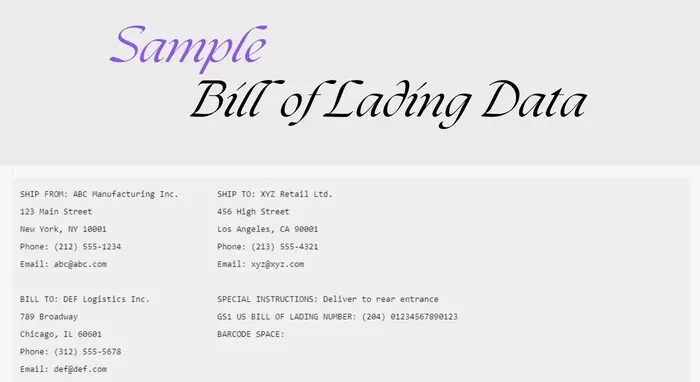Understanding the Bill of Lading (BOL). Have you ever wondered what that mysterious shipping document accompanying your precious cargo is all about? Look no further! Today, we delve into Bills of Lading, unpacking their significance and vital elements in easy-to-understand terms.
Think of a BOL as a passport for your goods. It’s a vital document issued by the carrier (think shipping lines, trucking companies, or airlines) confirming they’ve received your shipment and guaranteeing its safe transport to its destination. But the shipping document is much more than just a receipt!

Download the Sample Bill Of Lading Data.
Inside the BOL Vault:
- Who’s Who: The BOL identifies the shipper (you!), the consignee (where the goods are headed), and the carrier handling the journey.
- Cargo Confidential: Detailed descriptions of your goods, including quantity, weight, dimensions, and unique characteristics, ensure everyone’s on the same page.
- A to B Location: It spells out the origin (where your shipment starts) and the destination (its final stop).
- The Fine Print: This section outlines the shipping terms and conditions, covering special instructions and insurance details.
- Cost Control: The BOL specifies freight charges, clarifies who is responsible, and outlines any additional fees.
- Stamp of Approval: An authorized signature and seal from the carrier authenticate the document, making it legally binding.
Different BOLs for Different Folks:
There are several types of BOLs, each serving unique purposes:
- Straight Bill of Lading: This non-negotiable option ensures the goods reach the named consignee only. Think of it as a direct delivery ticket.
- Order Bill of Lading: Marked “to order,” this BOL allows ownership transfer by endorsement on the document, offering more flexibility during transit.
- Bearer Bill of Lading: This is similar to an order BOL, but ownership follows whoever physically holds the document, adding another layer of transferability.
Why are BOLs Important?
BOLs play a crucial role in various ways:
- Proof of Shipment: It serves as official shipping documentation for insurance claims and customs clearances and resolves shipment discrepancies.
- Ownership Transfer: Negotiable BOLs facilitate smooth ownership transitions during multi-party transactions.
- Contractual Agreement: The terms and conditions outlined in the BOL form a legally binding contract between the shipper and the carrier.
Remember: A BOL is a vital cog in the global shipping machine. Understanding its contents empowers you to track your goods confidently, ensure their safe arrival, and quickly navigate any logistical hurdles.
Conclusion On Bill Of Lading A Vital Shipping Document
In conclusion, the Bill of Lading (BOL) is crucial in the shipping and transportation industry. It serves as a receipt for the shipped goods, a contractual agreement between the shipper and the carrier, and a tool for ownership transfer. The BOL contains detailed descriptions of the goods, including quantity, weight, dimensions, and unique characteristics.
The shipping document also specifies the origin and destination of the shipment, freight charges, and any additional fees. There are different types of BOLs, each serving unique purposes and offering varying degrees of flexibility and transferability.
Understanding the contents of a BOL empowers you to track your goods confidently, ensure their safe arrival, and navigate any logistical hurdles with ease.
Related Topics:
Loading Items In A Car, Bus Or Truck In The EU Now
Calculating Car Import Duty In Nigeria And Vehicle Importation
